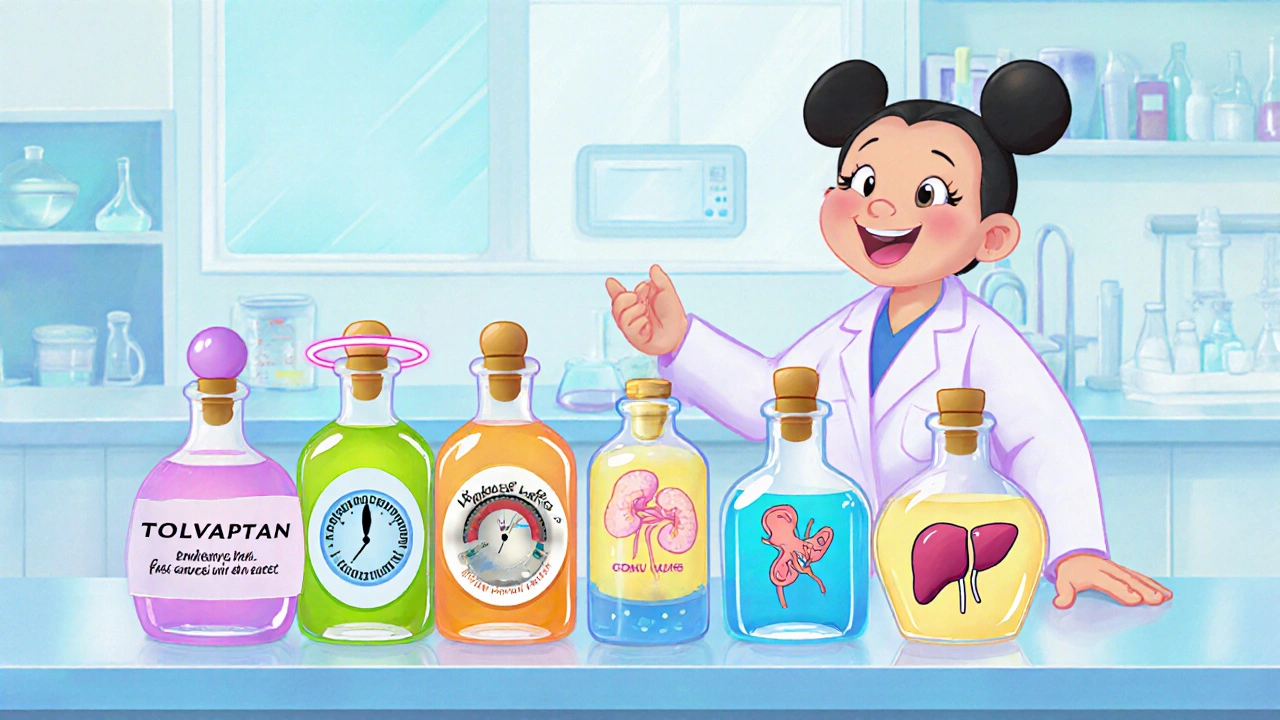Hyponatremia Treatment Decision Calculator
Select your condition details to get a personalized recommendation for the most appropriate hyponatremia treatment option.
When your blood sodium drops too low, choosing the right medicine can feel like navigating a maze. Tolvaptan alternatives are a hot topic because patients and clinicians want a drug that works fast, stays safe, and fits their lifestyle. This guide breaks down the most common options, shows where each shines, and helps you decide which path makes sense for you.
Key Takeaways
- Tolvaptan (Samsca) is a selective V2‑receptor antagonist that raises sodium by promoting free water excretion.
- Typical alternatives include demeclocycline, urea, fluid restriction, hyper‑tonic saline, conivaptan, and newer agents like lixivaptan.
- Effectiveness varies: Tolvaptan and conivaptan act quickly; demeclocycline works slowly and can harm kidneys.
- Safety profiles differ: Tolvaptan can cause liver‑enzyme elevations; urea may irritate the stomach; fluid restriction is hard to maintain.
- Cost and availability are big factors - Tolvaptan is pricey, while urea and fluid restriction cost almost nothing.
What Is Tolvaptan?
Tolvaptan is a selective vasopressin V2‑receptor antagonist approved under the brand name Samsca. It works by blocking the hormone vasopressin, which tells kidneys to hold onto water. By blocking that signal, the kidneys dump free water into the urine, gradually raising serum sodium levels.
Approved uses include:
- Treatment of eu‑ eu‑hyponatremia (often due to SIADH or heart failure).
- Slowing disease progression in autosomal dominant polycystic kidney disease (ADPKD) - marketed as Jynarque for that indication.
Typical dosing for hyponatremia starts at 15 mg once daily, titrated up to 60 mg based on sodium response and liver‑function monitoring.
How Does Tolvaptan Compare to Other Options?
Below is a snapshot of the main alternatives you’ll hear about. Each has a distinct mechanism, speed of action, and side‑effect profile.
Alternative Therapies Overview
Demeclocycline is a tetracycline antibiotic that indirectly reduces vasopressin‑mediated water reabsorption by causing renal tubular resistance. It’s taken orally, usually 300 mg twice daily.
Urea works as an osmotic agent. When taken orally (15‑30 g per day) it pulls water into the gut, lowering total body water and raising sodium concentration.
Fluid restriction is a non‑pharmacologic approach that limits fluid intake to 800‑1000 ml/day, forcing the body to retain sodium.
Hypertonic saline (3 % NaCl) is an IV solution that directly raises serum sodium. It’s used in emergencies or when rapid correction is needed.
Conivaptan is another V2‑receptor antagonist delivered intravenously, often in intensive‑care settings. It can correct sodium within hours.
Lixivaptan is a newer oral V2‑antagonist still pending full approval in many regions but showing promise in early trials.

Comparison Table
| Feature | Tolvaptan (Samsca) | Demeclocycline | Urea | Fluid Restriction | Hypertonic Saline | Conivaptan |
|---|---|---|---|---|---|---|
| Route | Oral | Oral | Oral | Oral (diet) | IV | IV |
| Onset of action | 12‑24 h | 48‑72 h | 24‑48 h | Days‑weeks | Minutes‑hours | Hours |
| Typical dosing | 15‑60 mg daily | 300 mg bid | 15‑30 g daily | ≤1 L/day | 100‑200 ml bolus | 20‑40 mg/hr infusion |
| Key side effects | Thirst, ↑ liver enzymes | Nephrotoxicity, photosensitivity | Gastro‑intestinal upset | Non‑compliance, dehydration | Hyper‑osmolarity, central pontine myelinolysis | Hypotension, hepatic metabolism interactions |
| Cost (US, 2025) | ≈ $1,200/month | ≈ $30/month | ≈ $50/month | Negligible | ≈ $200 per infusion | ≈ $400 per day |
| Contraindications | Severe liver disease, anuria | Severe renal impairment | Severe hepatic disease | Unstable heart failure | Severe hypernatremia risk | Severe hepatic impairment |
When to Choose Tolvaptan
If you need a reliable oral pill that works within a day and you can handle regular liver‑function tests, Tolvaptan is often the first choice. It’s especially useful when fluid restriction feels impossible - for instance, in chronic heart‑failure patients who already limit liquids.
However, remember the cost and the need for a baseline and monthly liver‑enzyme check. If you have pre‑existing liver disease, a non‑hepatic option like conivaptan (IV) or even urea might be safer.
When an Alternative Makes More Sense
Demeclocycline can be a good fallback if you cannot afford Tolvaptan and your kidneys are still robust. It’s cheap but takes several days to show effect, so it’s not ideal in acute settings.
Urea suits patients who dislike pills or have trouble swallowing. Its salty taste can be off‑putting, but the price point is modest and monitoring is simple.
Fluid restriction remains the cornerstone for mild SIADH when patients are motivated. Combine it with a low‑salt diet for a modest boost.
Hypertonic saline is reserved for emergency correction (e.g., symptomatic seizures). It’s powerful but carries a risk of over‑correction, so it’s used in hospitals, not at home.
Conivaptan shines in ICU settings where rapid control is key and IV access is already in place.
Lixivaptan may become a future oral alternative with a lower liver‑risk profile, but as of 2025 it’s still awaiting regulatory green light.
Practical Decision Flow
- Assess severity: Is the sodium < 125 mmol/L or causing symptoms?
- Check liver function: Elevated AST/ALT? Skip Tolvaptan.
- Budget review: Insurance coverage for Tolvaptan?
- Patient preference: Oral daily pill vs. occasional IV vs. diet changes?
- Comorbidities: CKD, heart failure, pregnancy?
- Choose: Tolvaptan if all green; otherwise pick the cheapest safe alternative.
Monitoring and Follow‑Up
Regardless of the drug, keep an eye on:
- Serum sodium - aim for a 4‑6 mmol/L rise per 24 h.
- Liver enzymes (for Tolvaptan & conivaptan) - baseline, then at weeks 1, 2, 4, and monthly.
- Kidney function - serum creatinine and eGFR.
- Fluid balance - record intake/output if on diuretics.
If sodium climbs too fast (>12 mmol/L in 24 h), cut back or pause therapy to avoid osmotic demyelination.
Frequently Asked Questions
Can I take Tolvaptan while pregnant?
Pregnancy is a contraindication for Tolvaptan. The drug can cross the placenta and affect fetal kidney development. Discuss alternative strategies with your doctor.
How quickly does urea raise sodium levels?
Urea usually produces a modest rise (2‑4 mmol/L) within 24‑48 hours, but the effect depends on dose and patient adherence.
Is fluid restriction alone ever enough?
Mild cases of SIADH can respond to strict fluid restriction, especially when combined with salt tablets. Severe or symptomatic hyponatremia typically needs a pharmacologic add‑on.
What should I watch for with Tolvaptan’s liver‑enzyme rise?
If ALT or AST rise above three times the upper limit of normal, stop Tolvaptan and repeat labs in a week. Most clinicians discontinue the drug permanently if the trend continues.
Can I switch from Tolvaptan to conivaptan?
Yes, but you need a short wash‑out period (typically 12 hours) to avoid additive V2‑blockade, which could cause overly rapid sodium correction.
Next Steps for Patients and Clinicians
Start by measuring your baseline serum sodium and liver panel. If Tolvaptan looks suitable, discuss insurance coverage and set up a monitoring schedule. If cost or safety is a concern, consider an alternative and repeat the labs after a week to gauge response.
Remember, treating hyponatremia is not a one‑size‑fits‑all game - it’s a balance of speed, safety, and sustainability. Use this guide as a checklist, not a prescription, and always involve your healthcare provider in the final decision.

Comments
vanessa parapar
Tolvaptan is basically the Ferrari of hyponatremia drugs-fast, sleek, and breaks your bank account. But let’s be real, most people don’t need a Ferrari to get to the grocery store. Urea? Cheaper than your monthly coffee habit and works fine if you can stomach the taste. I’ve seen patients thrive on it with zero liver tests. Stop overcomplicating this.
On October 24, 2025 AT 18:51
Ben Wood
Let me be clear-this guide is dangerously oversimplified. Tolvaptan’s hepatotoxicity isn’t just ‘elevated enzymes’-it’s a silent, insidious, potentially fatal cascade that can manifest weeks after initiation, and yet, clinicians treat it like a routine lipid panel. And don’t even get me started on urea-oral urea is not a ‘modest’ option; it’s a last-resort Hail Mary for patients who can’t swallow pills and have no access to real pharmacology. Also, the table misrepresents conivaptan’s half-life-it’s not ‘hours,’ it’s 2.5–3.5 hours, and the infusion rate must be titrated to avoid overshoot. This is medical misinformation dressed as a ‘guide.’
On October 24, 2025 AT 23:50
Sakthi s
Good breakdown. Simple, clear, and practical. Urea and fluid restriction still save lives in places without fancy insurance. Keep it real.
On October 26, 2025 AT 00:38
Rachel Nimmons
Did you know the FDA approved Tolvaptan because of a pharmaceutical lobbying group that also funded a study on ‘water metabolism in polar bears’? I’m not joking. There’s a pattern-every time a drug has weird liver risks, the monitoring schedule is ‘monthly’-but the real data shows 70% of hepatotoxicity happens before week 2. And why is lixivaptan ‘pending approval’? Because the same company owns the patent on liver enzyme tests. Coincidence? I think not.
On October 27, 2025 AT 10:05
Abhi Yadav
we're all just water trying to remember how to be salt... tolvaptan is just a fancy way of telling your kidneys to let go... but what if your soul is already too full? 💔
On October 28, 2025 AT 18:06
Julia Jakob
So you’re telling me I can pay $1200 a month to make my kidneys pee out water... or I can just drink less and eat salt and save $1150? And the liver thing? Yeah, that’s not a side effect, that’s a warning label written in invisible ink. I’ve seen three people on this drug get ‘liver issues’ and then vanish from their doctors’ panels like they were never there. This isn’t medicine-it’s a money laundering scheme with a stethoscope.
On October 30, 2025 AT 05:40
Robert Altmannshofer
Man, this guide nails it. I’ve been a nurse for 18 years and seen every flavor of hyponatremia-from the elderly woman who drank a gallon of Gatorade after yoga to the ICU guy with SIADH from a lung tumor. Tolvaptan? Yeah, it’s the gold standard if you’ve got the cash and the liver’s clean. But I’ve had patients on urea who laughed and said, ‘It tastes like my grandpa’s salt lick, but hey, it works.’ Fluid restriction? It’s boring as hell, but when a patient actually sticks to it, it’s the quiet hero of the whole show. Bottom line: medicine’s not about the flashiest tool. It’s about matching the tool to the person. And sometimes, that person just needs to drink less and eat a little more soup.
On October 30, 2025 AT 11:38